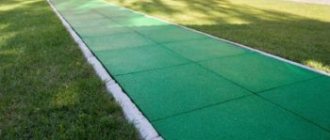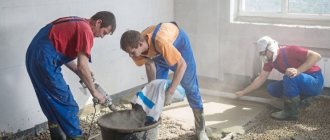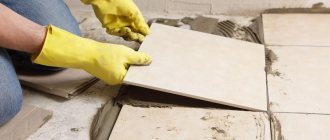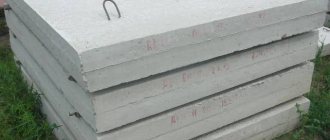The main thing for high-quality installation of the coating is careful preparation of the base, which, as a rule, is a gravel-sand cushion, and in difficult conditions - concrete. Paving slabs allow you to create a variety of color compositions and patterns, but the durability of paths and platforms largely depends on the correct determination of what crushed stone is needed for laying paving slabs in a particular case.
Concrete tiles
These are paving stones of artificial origin. For the production of stone the following is used:
- Cement. The optimal option for PC 400 is M400 Portland cement without slag or mineral additives.
- Filler. Classical:
- fine crushed stone no larger than 5–10 mm in size;
- coarse sand 1~3 mm;
- granite screening with a fraction size of up to 5 mm.
- Water. Pure, without mechanical and chemical impurities, with an acidity index of ph ≈ 7.0. Liquid temperature 18~25°C.
- Plasticizers. With the recommended water-cement ratio (W/C) for concrete paving stones of ~0.4, the solution turns out to be hard. Increased plasticity is facilitated by the introduction of thinners into the composition. For private production, we can recommend liquid detergents with ph = 8.0~9.0. After introduction, the mixture is elastic with a good degree of workability.
Tile requirements
Artificial stone is used outdoors and is therefore exposed to:
- temperature changes, from -20~50 to +30~60°C;
- ultraviolet and other spectrum of solar radiation;
- precipitation;
- external mechanical loads, such as the weight of a pedestrian or car.
A product that meets the requirements of regulatory documents can withstand these tests: GOST 17608-91 “Concrete paving slabs”:
- compressive strength 300~400 kgf/cm²;
- degree of water absorption, no more than 4.5% of the total volume of the product;
- abrasion coefficient not exceeding 0.4 g/cm²;
- frost resistance within F300~F400;
- service life 15~30 years.
These indicators are valid for production using the vibration casting method.
Production
Three main methods are common:
- Vibration pressing. A semi-dry mixture based on a cement binder is placed in a matrix (mold). The latter is fixed on a vibrating frame. The concrete solution is compacted with a punch. The process is highly automated and allows for high labor productivity. Used for mass production of tiles.
- Hyperpressing. The tile mortar is compacted by compressing the upper and lower punch. The method allows for a high degree of automation. Cost-effective when producing large quantities of paving stones.
- Vibrocasting. The cement-sand mixture (CSM) is placed in a polymer container. The mold is placed on a vibrating table to compact the solution. The degree of readiness is determined by the appearance of cement laitance. The method is beneficial when producing small series of floor stones, that is, for small businesses.
Why do you need a seal?
At first glance, sealing paving slabs is an unnecessary operation. Especially for lightly loaded products such as paving stones for garden paths. This is not true. Uncompacted concrete stone has micro- and minivoids, which leads to:
- Reducing the density and strength of the part. The risk of destruction from external loads increases.
- The degree of water absorption increases. In cold weather, freezing moisture, expanding, will lead to internal cracks and complete destruction of the stone.
On the other hand, the compacted mixture is evenly distributed over the mold - the product is obtained with smooth edges. An additional factor: during vibratory casting production, the top part of the tile is smooth.
The compaction operation allows you to create an internal dense structure that does not contain pores or voids. During vibration, the liquid fills the space between the filler, displacing the air out.
Mixture composition
An approximate list of components for the production of paving slabs at home is presented in the table.
| Concrete grade (strength class) | Components, bucket | Output of the finished mixture, bucket | ||
| cement | fine sand | crushed stone | ||
| M250 (B20) | 1.0 | 2.5 | 3.5 | 4.2 |
| M300 (V22.5) | 1.0 | 1.7 | 3.2 | 4.0 |
| M350 (B25) | 1.0 | 1.5 | 2.8 | 3.5 |
| M400 (B30) | 1.0 | 1.0 | 2.5 | 3.0 |
The error inherent in the volume fractions leads to the production of a lower-quality composition. The transition to mass units will allow you to prepare concrete with more precise parameters:
| Strength class | Cement, kg | Crushed stone, kg | Sand, kg |
| IN 20 | 10.0 | 39.0 | 21.0 |
| B22.5 | 10.0 | 37.0 | 19.0 |
| B25 | 10.0 | 27.0 | 16.0 |
| B30 | 10.0 | 26.0 | 12.0 |
FEM can be made from sand-cement mixture. Composition proportions:
- cement PC400 – 1 share;
- coarse sand – 3 shares;
- water ratio – 4 liters per 10 liters of binder;
- dye – up to 3~5% of the mass fraction of cement.
Tools and materials for preparing the base for paving slabs
To lay any area with tile briquettes you need appropriate tools and building materials
:
- A level is a construction item that is simply indispensable for checking the horizontalness of the briquette being laid;
- Paving slabs, as well as the amount of border required for it;
- Stakes and pins made of metal or wood;
- A watering can, hose with a divider or other device for moistening the foundation;
- Broom;
- Rake, devices for leveling the base (metal corner, channel);
- A shovel or pick for removing the top layer of soil, as well as for digging a trench under the frame;
- Twine for marking the territory.
When everything you need is available, you can start working.
Concrete for laying
Laying paving stones is carried out:
- For sand mixture (bedding, pillow). The method is applicable in dense soils with low groundwater levels and no heaving.
- New concrete base: sand, peat, bulk soil predominate.
- Existing base: there was a need to refresh the old dilapidated concrete surface with paving stones.
Sand base
- The soil layer is removed.
- Sprinkling is carried out with crushed stone (gravel) with a fraction of up to 20–25 mm.
- A cushion of coarse sand is formed. You can apply the grus at home.
- Border stones are installed on the mortar.
- The tiles are being laid. The stones are installed close to each other in a checkerboard pattern.
- The top layer is filled with fine sand. Excess mixture is removed with a stiff brush.
New concrete
Stages of work:
- A pit is formed and the fertile layer is excavated. The depth should be at least 40~50 cm.
- Concrete proportions:
- Portland cement PC-400 – 1 share;
- construction sand – 2.5 (1.5) shares, pedestrian path (car);
- crushed stone – 4 (2.5) shares, sidewalk (vehicle zone).
- A curb stone is installed and fixed to sand-cement mortar. Drainage grooves are made on the external sides to remove precipitation or melt water.
- A cushion of crushed stone with a fraction of up to 25~30 mm is poured. Leveled and compacted using a vibrating platform. Reinforcing mesh is laid under the parking lot.
- The concrete mixture is diluted and placed on the prepared base. After 3~4 meters, a transverse thermal joint is installed from a plank up to 10~15 mm thick. The surface is formed and compacted with a vibratory screed (wide strips) or manually - for garden paths.
- It is advisable to cover the fresh surface with plastic film. This will eliminate premature drying. Cement hydration will proceed as planned.
Technology of work execution
Tamping a layer of crushed stone with a vibrating plate
The base of the paths is formed from crushed stone or gravel (for pedestrian paths), which are covered in layers 10-15 cm high, followed by compaction of each. The top 3-5 cm of backfill with screenings is leveled using a rule so that the laid paving elements are 1 cm above the design level before they are processed with a vibrating plate. This makes it possible, during the compaction process, to level out the permissible difference in the heights of concrete products that arise during their production.
It is recommended to lay geotextiles between the layers of crushed stone and screenings (sand), which will give the base greater durability, preventing spillage of the upper fraction into the crushed stone.
You should not use cement-sand compositions to form the bedding - this complicates the dismantling and laying of the tiles again if the need arises (for example, due to the repair of underground utilities). In addition, the use of such solutions makes it difficult for atmospheric moisture to seep into the soil from the paths and reduces the elasticity of the surface when subjected to loads, which leads to damage to the coating during operation.
Buy gravel and granite crushed stone, the price in Moscow for which in our company is the most favorable! Just call us by phone +7 (495) 229-39-07!
Laying tiles
Installation of paving slabs has its own characteristics:
- the coating is exposed to atmospheric moisture or melt water;
- temperature varies over a wide range (seasonally);
- it is necessary to make a slope for water drainage;
- the tile laying solution firmly fixes the tile, limiting displacement.
Paving stones are installed on mixtures of different composition and consistency:
- Gartsovka. Dry mixture for laying paving slabs. The ratio of cement and sand is 1/5. The seams are filled with the same mixture.
- Tile adhesive. The composition is used for external work. The mixture is prepared according to the recommendations given on the package. Layer thickness 5~10 mm. The seams are rubbed down with glue, PDS or grappling.
- Classic recipe. A cement mixture of binder and sand in proportions of 1/3~4. The period of movement is 25~30% longer than that of tile adhesive. The thickness is within 2~3 cm. It is advisable to mix the components for masonry 5~15 minutes before the installation of the stone. It is more convenient to make the solution with a mixer. The slope (up to ~2 degrees) and flatness are controlled by the rule.
A budget option for installing paving slabs is to use a grappling machine. The use of tile adhesive is the most expensive option, but provides reliable adhesion of the base to the paving stones.
Why do you need a base for paving slabs?
Laying tiles
- a complex process consisting of several stages, each of which is carried out in accordance with technology and compliance with building codes. Otherwise, it is impossible to ensure the strength of the coating.
In this process, it is very important to use support for installation so that dips and unevenness do not appear in it over time. Any pavement needs a foundation. The durability of the track surface is determined by such factors as the prepared surface
. In order for paving slabs to look well-groomed and successfully fulfill their purpose, it is important to strictly follow the methods of its creation. Preparation of the base is one of the most important stages of this technology.
Base strength
must be compatible with future pavement loads. For paving a path or platform for a summer cottage, a private cottage, where the potential impact will be relatively small, it is enough to use a sheet no more than 20 cm thick. Under the road surface of the roadway, a support with a thickness of 30-40 cm should be prepared in order to ultimately obtain a coating of increased endurance.
How to create a concrete base for paving slabs
Paving stones can also be laid on mortar
. If you are going to use this method, ensure that you have a secure and strong concrete base for your sidewalk. Considering the thickness of the base, you need to dig a hole in the soil 5-10 cm larger.
The list of actions taken to arrange the path practically coincides with the activities already described
. But the sand layer needs to be made somewhat thinner; only a few centimeters are enough to fill the voids in the gravel, since the rest of the space will be filled with concrete.
The solution can be prepared using different methods
. For example, mix sand with fine screenings and cement, adding slaked lime (detergent or PVA glue) for plasticization. Then the concrete is poured and leveled. Formwork is done along the edges. It can be made from any boards or plywood, pre-greased with grease so that the concrete does not stick to the surface.
You can lay tiles on a subfloor
, it is not at all necessary to make a screed before doing this. If you lay the pavement without waiting for it to dry, then take care of the thickness of the layer, which should allow the elements to be adjusted.
Base for paving slabs: preparatory work
Before making a base for tiles, you need to prepare the area
. Markings are carried out on the land plot planned for laying paving stones. Using a shovel, the top fertile layer of soil is removed. This will have to be done with special care, otherwise your sidewalk may be damaged by sprouting vegetation in the future. A simple shovel or other gardening tools will make this quick and easy.
Once the turf is removed, the surface of the area will remain uneven. And to change this, a base material is added to the surface - for example, sand. To paving the surface, you need to achieve a perfectly flat bottom, compacting it as intensely as possible. After all, if the support is soft, the paved path will undergo deformation and the paving stones will shrink. Before compaction, the base must be thoroughly moistened.
Owners of large shopping centers or salons providing premium services can afford to completely cover the adjacent territory with paving slabs; sometimes such coverings are found in urban construction. But not a single owner of a country house will pave his entire plot of land. He will lay out paths connecting the gate to the cottage, crossing the garden, backyard and so on. Consider the location of the path to the house and from it to the main buildings
necessary in order to preserve plantings (including perennial fruit-bearing trees) and a lawn, so that in the future you will not have to walk through dirty slurry in bad weather, and simply in order to beautifully and neatly decorate your personal plot.
The choice of foundation material determines the type of soil
. If it is mobile, then you cannot do without pouring concrete. Such a base will be required even for a pedestrian path with a relatively low level of load. Dense soil, even for covering under a car, allows the use of a sand-cement cushion.
In order for the result to please you for a long time, certain conditions must be observed
, which are of great importance for preparing the surface for paving.
Meeting these requirements
will help you make a path that will last a long time, decorating the surrounding area. So what should you do?
- Drainage
. Take care to eliminate excess water so that it does not linger under the sidewalk and wash it out.
- Waterproofing
. The substrate must be constructed in such a way that it prevents the accumulation of excess liquid.
- Gutter
. The device of the slope and drainage grooves will help drain the liquid.
- Alignment
. We have already mentioned more than once that the surface of the soil prepared for the foundation must be extremely flat. There can be no compromises here.
- Sustainability
. All layers of the base must be extremely stable, eliminating movement, in order to subsequently avoid deformation during shrinkage.
- Deepening
. You should first prepare a small hole in order to arrange drainage in it, and you also need to create a track for the future path.











